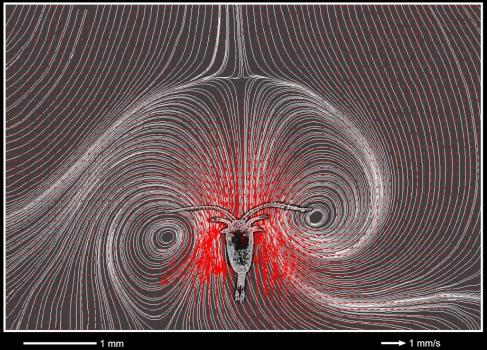A new study explains the optimal size range of zooplankton prey.

Click here to prey captures in slow motion (video sequences published as supplementary material for the article)
Zooplanktonic organisms feed on prey of different sizes. However, there is an ‘optimum range’ within which clearance rates are maximum. What defines that range? For example, copepods are not true filter feeders, therefore prey size can not be predicted from ‘mesh size’ considerations.
In a new study, the feeding behavior of the marine copepod Temora longicornis was studied to gain insights into its food size spectrum. This copepod creates continuous feeding currents from which it captures entrained particles. We considered the detection distance (and hence the capture area) and the flow of water passing through the capture area. This defines the theoretical maximum volume a copepod can scan per day (this was estimated from direct video observations and flow visualization in high-speed video recordings). These maximum values were then compared to (and matched) feeding experiments with bottle incubations. The result show for the first time that clearance rates in this type of copepods can be predicted from morphological, behavioral and functional traits.
The article was published in Marine Ecology Progress Series (click here to see the article in the journal’s website)
Complete reference
Funding
This work was led by Dr. R. Gonçalves from EFPU and was done together with an international team in Technical University of Denmark. The sutdy was supported by Centre for Ocean Life (VKR Foundation) and additional support to RG from CONICET, FONCyT (PICT 2438) and The Danish Research Council for Independent Research